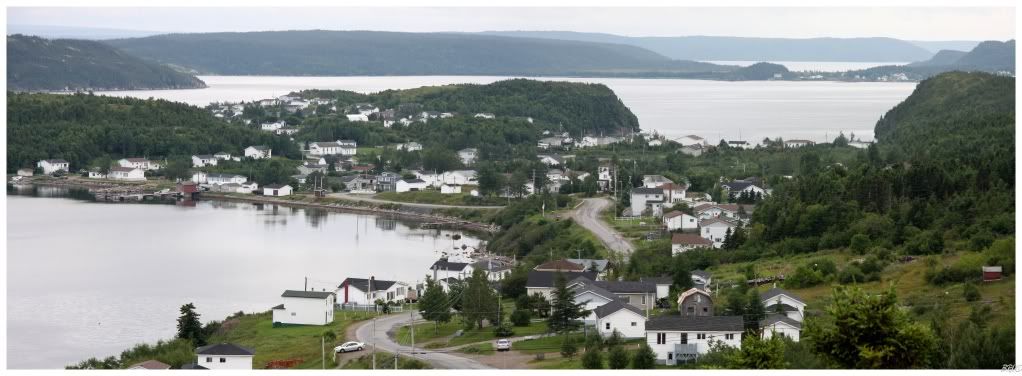|
I hate cliffhangers and clickbait and Mark Zuckerberg doesn't let me edit this text anymore, so I've written a sentence here to skip and I'll have to delete it from my website in a minute, once I share this. After we did pretty good catching cod, the first stop was another stage where the fish was cleaned and a couple cold ones were handed out. As I mostly stood around, the sun was starting to come out as the grey sky dissipated with clouds breaking from west to east. |
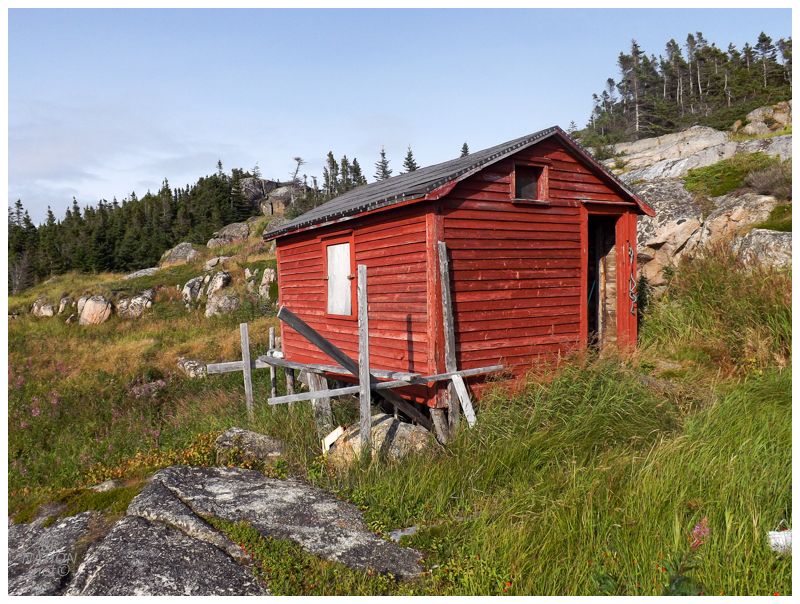
Afterwards, I took the opportunity to walk up a grassy hill to a couple of sheds to the north. This was the area of Shane's grandparents' house and store, and although I can't remember if either of these sheds belonged to them, I would think so. |

Where I thought the red shack was abandoned, it was just a case of someone leaving the door open. As for the other one, I skipped it because a poor beaver or muskrat had fled underneath that shed multiple times now, narrowly escaping terrorizing dogs. |
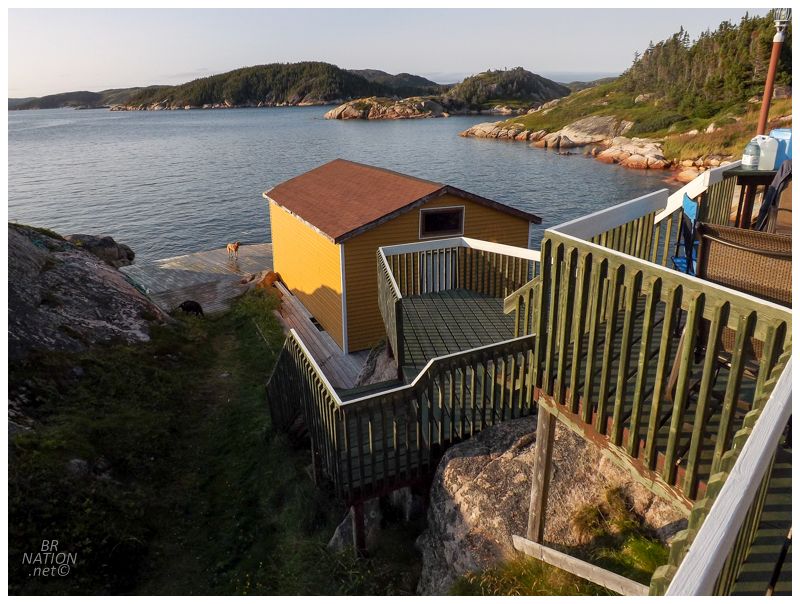
Returning to the main house, I discovered that some of the cod had made its way into a simple ceviche, which was refreshing and delicious, the lime juice and cilantro with the fresh cod just delightful. I raved about it and Anja & Tavish brushed it off like it was nothing. Looking down from the cabin, I could see some of the group incredibly stand-up paddleboarding right down the tickle and all the way to the other end of town. I stood blown away with this idea of being confident enough to risk it all out in the ocean on a simple paddleboard, especially with the healthy oceanic fear I've had instilled in me since arriving in Atlantic Canada. (Later I would learn that Shane has taken a stand-up paddleboard (SUP) over to Silver Fox Island, because of course he has. It's a good thing there's no Fair Island Nation, because I'd be losing a lot of readers here.) |

I only went down to the harbour to check out the scene, but then everyone was taking turns and adamant that it was totally safe. Which was all good and fine, but I didn't see a nearby pool or shallow lake...and apparently these people wanted me to try this out in the ocean?! Straddling the board and carefully getting my feet under me, I deliberately stood from a crouch and found the board steadier than I imagined. One of the expert guys kept close in case I needed rescuing, but slowly paddling and pushing myself, I began making concentric circles wandering further and further from the dock. At some of the furthest points, my heart raced with how good I was doing, but then as I looked back, I was shocked when I realized how far I was from land. I don't know if they make SUP boards easier to balance than surfboards, but it was surprisingly easy. I'd still pass on taking one over to Silver Fox Island though. |
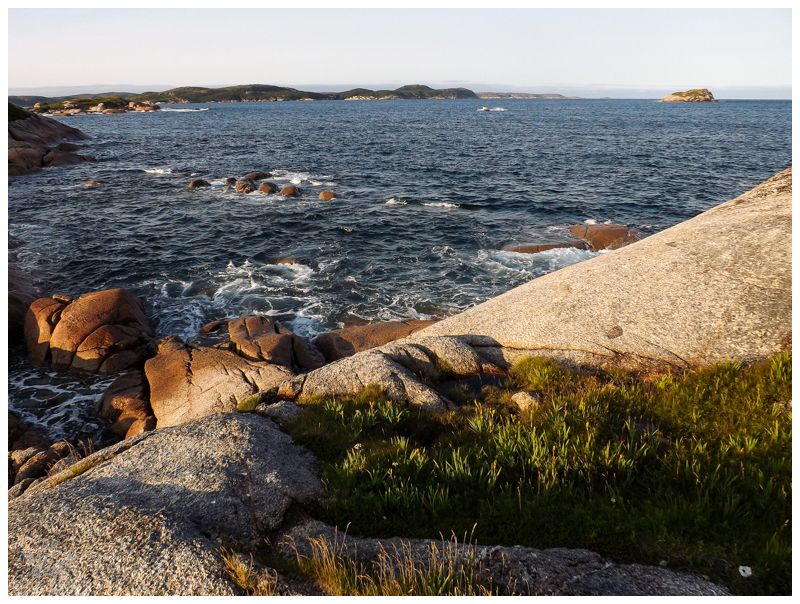
Following the paddleboarding, the crowd dispersed and I took the opportunity to do one of my favourite things in these resettled places, that is, find somewhere good to watch the sunset. Heading towards the northwest point of the island, I could finally see over the northern hills and out to sea. Silver Fox Island was clearly visible and North Island shined off to the east in the late day's light. |
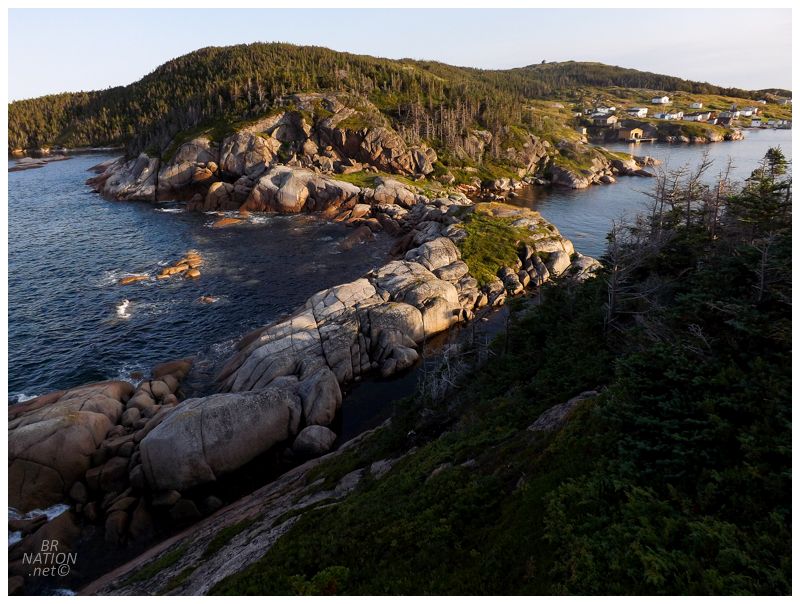
Crossing a rock bridge connecting the main part of Fair Island to the little slab of land at the northwest point, this was now Cuckoo Point, where both Shane's grandfather's boat and the old water taxi lay wrecked nearby. Apparently you can see the ships ribs if you know the right place to look. |
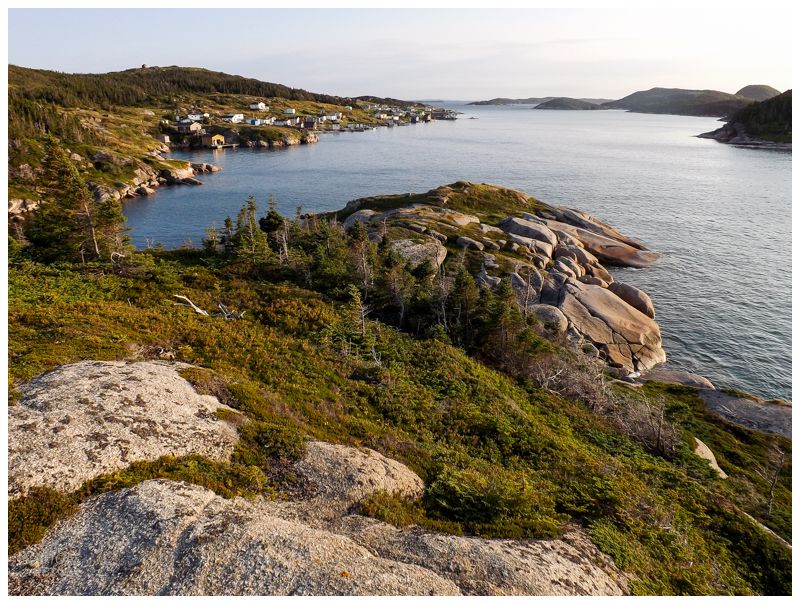
Following the pleasant overcast times, it was now a glorious evening. I took the opportunity to send my friend Holizko a selfie, letting him know that I finally made it to Fair Island, after he gave me the business about never being out here. Holizko has this way of getting under people's skin by asking further questions although you've already admitted that you're uninformed or inexperienced. He inquired, "wait, you've never been to Fair Island? Out by Indian Bay? It's really nice, I think you'd like it. You should go. You've never been? Really? But you've been everywhere? What do you mean you haven't been?" Well now I've been. Part of the selfie was about getting retribution, but Holizko was also being genuine about my need to get out here. From my initial malaise towards this area of Newfoundland, I'd now discovered that these further out Bonavista Bay islands were stunning with their bare granitic rocks and limited forests. Sitting here at the golden hour, the beauty of Fair Island was clear and I was so happy I came. I thought maybe this would be a case of checking off a place, but I was already fantasizing about returning. |
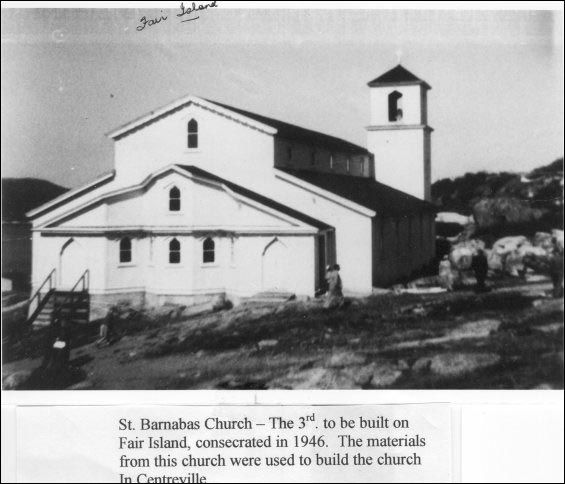
Picture from 1950, courtesy Maritime History Archive
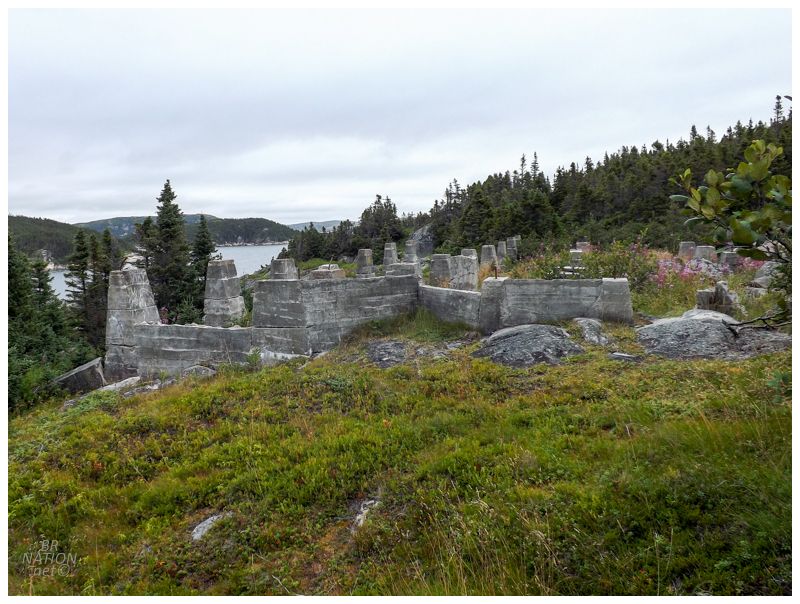
Climbing down from Cuckoo Point, I found everyone back at the cabin and more of the cod about to become dinner. This time there was a giant, propane-fueled wok filled with oil, where the cod was being dunked, plucked out and the incredibly fresh fish consumed within minutes. From Bonavista Bay to mouth in mere hours, this is the moment I think of when mainlanders ask me if I eat much seafood out here. The next morning the clouds returned, but I needed to get walking around the village itself as I was running out of time. I'd spotted the edge of these concrete pillars on the first day, but didn't quite grasp the extent of them at the time. Thinking about this old picture of St. Barnabas Anglican Church from 1950, I was now picturing the grand church sitting atop this old foundation and impressive Fair Island all around. |
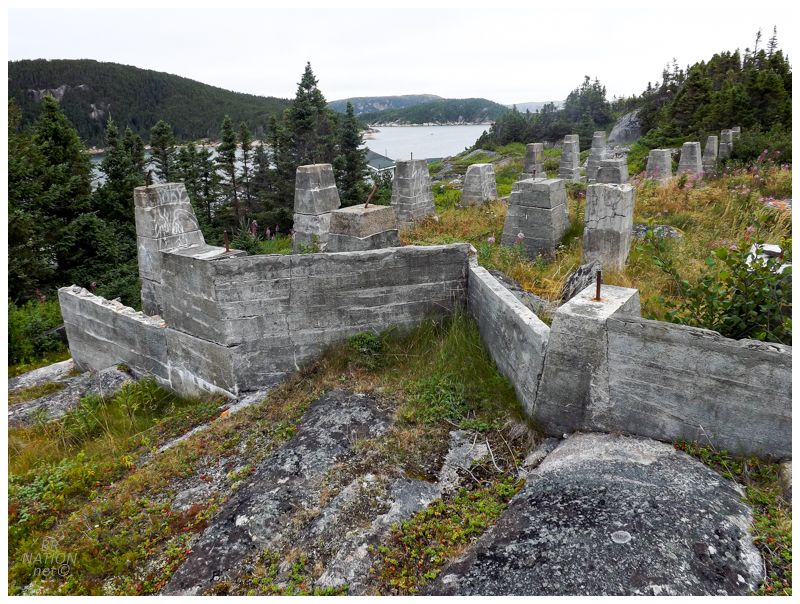
Near the end of the 1600s, fishing operations moved west and north into Bonavista Bay from the town of Bonavista. Fair Island, being quite offshore and with great access to the nearby fishing banks, was one of the first places settled in this area. By 1681, there were 16 summer residents at Fair Island, fishing from 3 ships. The Treaty of Utrecht gave France the rights to these fishing grounds and temporarily expelled the English fisherman, but French neglect led many of the English to return by the late 1700s. Richard Rogers from Sheffield England was the first to settle permanently at Fair Island around 1800, and a Rebecca Rogers was baptized at Vere Island (now Fair Island) in 1830. Eventually Richard Rogers' direct relatives would inhabit Silver Fox Island, Deer Island, Sydney Cove & Round Harbour, leading to one obvious question: just how many relatives did ol' Richard Rogers have? Other families arrived between 1810 and 1840, originating from places like Devon, Cornwall, Liverpool and one family from Ireland. The population was 105 in 1836 and the first school was soon established. Bishop Feild visited on September 7, 1846 and consecrated the first version of St. Barnabas Church. |

By 1869, the population ballooned to 212. Neither the inshore fishery or the island itself was suitable to serve this many people, as good garden soil was rare & some of the best land was used for the cemetery. Therefore, people left seasonally to go work the Labrador Fishery. This involved painting and fixing the schooners in early May, sailing to St. John's for salt and supplies in late May, and then heading up to temporary fishing villages in Labrador until September. Upon the return of the fishing schooners, the fish would be unloaded and cleaned/dried/salted in Fair Island, before eventually being brought to Water Street in St. John's. Much of the autumn and early winter was spent on nearby Lewis Island or the island of Newfoundland, cutting wood for the upcoming winter. The nearby town of Trinity was even founded by a Fair Islander by the name of James Brown, who built a sawmill at the mouth of Southwest Pond Brook. Brown then appointed his son Sitnah to manage the mill and build a home nearby. Other Browns, as well as Peter Pond & Israel Gibbons, would also eventually leave Fair Islands to work at this sawmill and in the woods of Trinity. The village would first appear in the census in 1901 with a population of 15. |
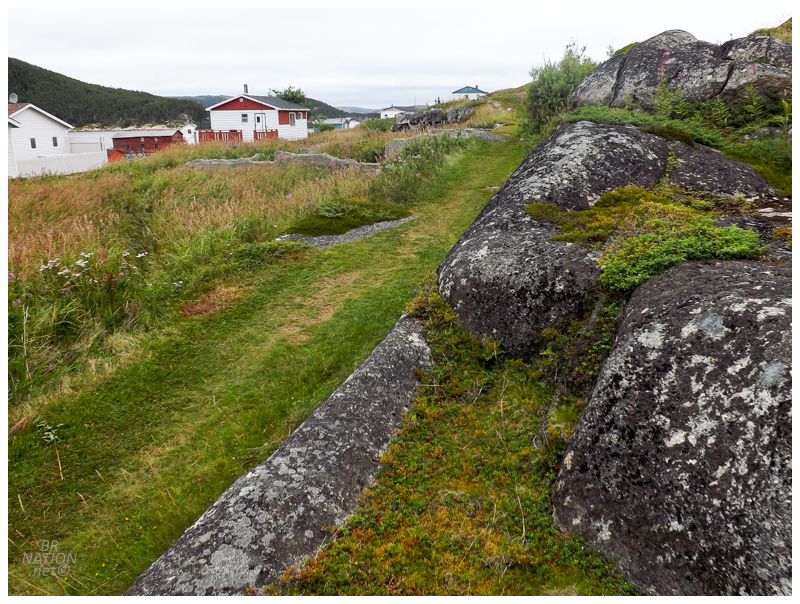
Fair Island had 12-14 schooners involved in the Labrador Fishery, the Feltham lobster factory employing 31 people, a church, a school, the Orangeman's Lodge #47 "WALLACE" and regularly scheduled mail. I found their mail delivery interesting. At first, mail would go from a child's cart to Middle Brook, then horse cart or ox cart past Lockyer's Bay and Trinity Bay, where it would await a pickup by one of the Fair Islanders. In later years, a boat that was an extension of the Newfoundland railway, would meet the train in Gambo and make regular mail delivery stops in Fair Island. |

Eventually, the Labrador fishery started to decline in the 1930s, but even by 1952, Fair Island still sent four ships up to Packs Harbour Labrador. Regardless, more and more men found regular work in the pulpwood industry, with eighty of them employed at Indian Bay in the same year. Working on the "mainland" island of Newfoundland and commuting from Fair Island, this led some men to leave Fair Island and move their families to nearby Indian Bay, Trinity or Wareham. Another appealing factor was the new North Shore Highway, which grew closer by the year, with new highways approved based on the population that would be connected. For a place that was only ever connected by sea - and remotely at that - some islanders were enamored with the idea of a constant connection to the outside world. |

Southcentral Fair Island, 1959. Picture from Settlement Migration in Central Bonavista Bay Newfoundland, Clifford Grant Head, B.A., 1964.

The same view, Southcentral Fair Island, 1964.
From 1955 to 1959, twenty two families moved from the Fair Islands to Hare Bay, Trinity, Black Duck Cove and Catalina. This included all of Paul's Island. The first house was moved from Fair Island in 1958. Buoyed by 38 empty oil drums, it was originally moved to Black Duck Cove (between Wareham and Centreville), then moved up to a better, more gravelly spot. Residents would later get chesty about the number of oil drums their house needed, where a 50 oil drum house was obviously more stately and grand than a measly 30 oil drum house. Crown Lands applications exploded from this point forward, with Fair Islanders looking to move to the "mainland" and applying for building lots along the road. Worried about disorganized strip development, the provincial government surveyed and platted 100 lots in somewhat of a grid system, with designated lots for a church, school and shops. This area, just to the south of the established settlement of Wareham, was to be known as Centreville. In addition to the applications they already had, the provincial government also circulated flyers advertising new plots to the remaining Fair Islanders, as well as any other remaining outport Newfoundlanders, such as those on Silver Fox Island. An aside: I thought the unique thing about Bide Arm, up by Englee and Roddickton, was that it was the only spot where resettlement created a new community. Instead, I guess Bide Arm was a matter of settling a harbour where there was never a community, while Centreville was a matter of just affixing some lots next to a highway. |
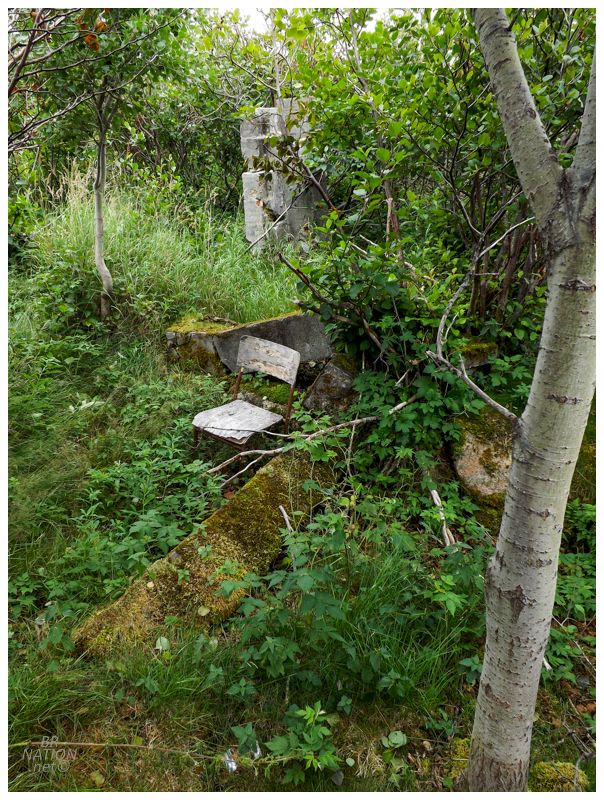
The new school in Centreville would draw out the rest of the Fair Islanders, with the last 36 families committing to taking the government buyout and moving during the summer of 1961. And if leaving the only home they ever knew wasn't bad enough, a monumental forest fire ravaged the woods all the way from Hare Bay to Carmanville (past Musgrave Harbour) the summer of their move. This meant that some people waited with - and sometimes inside - their floating homes out in the harbour overnight, to see the next day's wind direction, and whether the forest fire was going to flatten the burgeoning village of Centreville. |
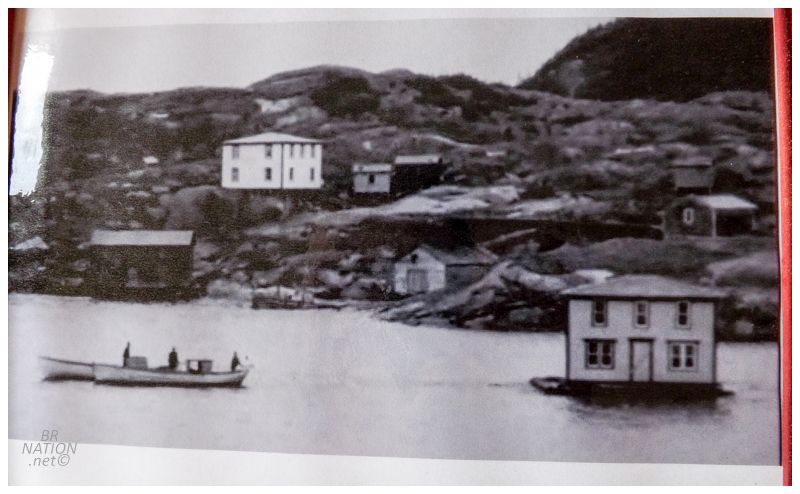
The Fair Islanders moving a home. I think the shed at dead centre might be the red shed I explored in this update.
This wave of provincial resettlement offered those displaced between $150 and $600. If you used government assistance (tractors/boats) or could move your house, you were offered less, but if you did it unassisted or it was impractical to move your house, you were offered a bit more. Everyone who left Fair Island between 1957 and 1961 was given $630. |
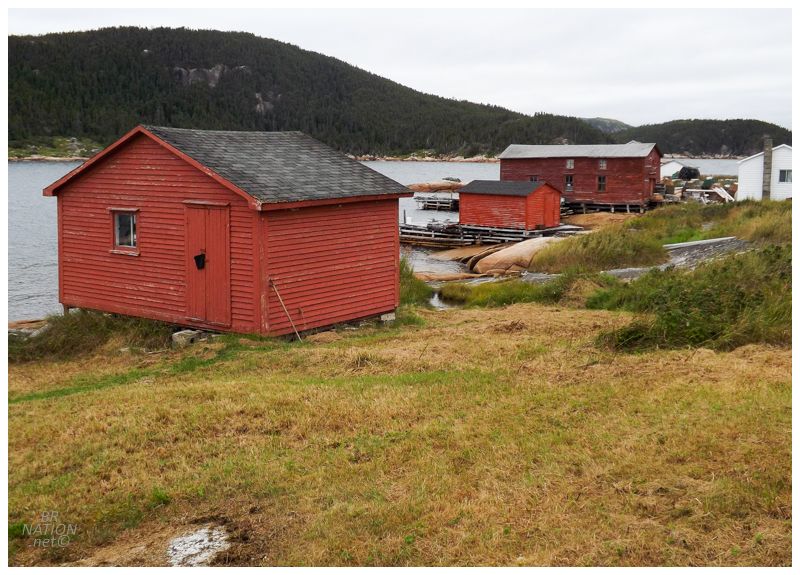
As for the personal connection, both Shane's uncle and grandfather towed their houses from Fair Island to the "mainland". Unfortunately, his uncle's house burned down somewhere along the way, while his grandpa's house was torn down in the mid-2000s. The Maritime History Archive shows a house that I assume is still standing and there are plenty others. I'm definitely going to cruise through more of Centreville next time I'm in the area, peering at the ones that look older. I'm also going to check out the Resettlement Museum, which is housed in the old Orangemen's Lodge that was floated over from Fair Island. This is another reason I was so happy I came to Fair Island - I knew Centreville and Wareham previously from needing to turn off the highway to check them off my list of visited communities, but now it's not just an exercise in checking things off. There's actual history, appeal and tie-ins here, making the two places much more interesting. |

The Fair Island transplants who worked in the woods were able to continue for a few more years by harvesting the burnt remains after the forest fire, but eventually the forests didn't have anything else to yield. In addition, chainsaws were becoming cheaper and other mechanization further reduced the workforce. This forced the Fair Islanders to go back to the fishery & that wasn't all that easy from inland Centreville. Instead, they returned to Fair Island and rebuilt old stages and repaired temporary sheds with whatever wood was available, allowing them to persecute the inshore fishery and supplement their struggling income for the next few years. |
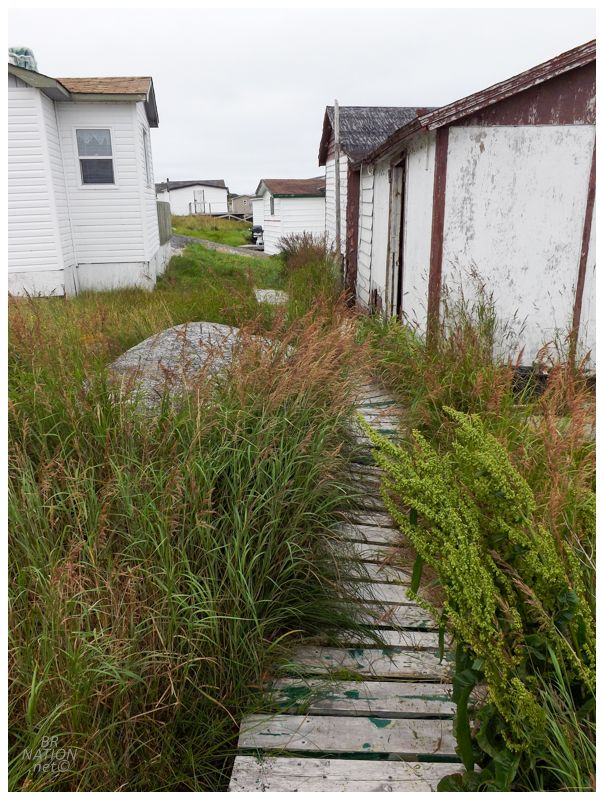
I picked my way down through the houses, along the pathways and out to the shoreline rocks. Remarking earlier on the number of people around, I was told that there'd be 50-60 more people if this weekend's weather was better. It would seem this place has taken quite well to becoming a busy cabin community. |

The last thing I checked out was North Harbour, just over the hill behind Shane's place. He'd later tell me that there's usually hermit crabs here, but I didn't even know we had hermit crabs or how small they are in Newfoundland, so I mostly looked out to sea and enjoyed the solitude. |
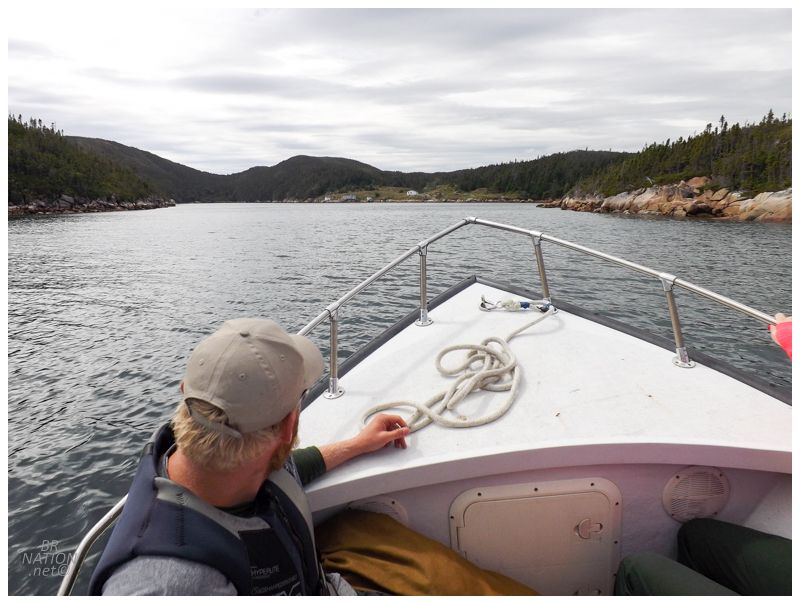
The whole weekend seemed to fly by & just like that, it was time to throw all of our belongings back into the boat and head off. With my interest in resettled places, Shane brought us on a little tour of the bay, going past Paul's Island and banging a right over to another forgotten place, Sydney Cove. With Sydney Cove surrounded by forest and spread out, I was happy our Fair Island instead allowed me to see rugged coast and a dense village with little, hidden pathways. Although, an old map of Sydney Cove shows a cemetery up in the hills behind the town, which I would definitely be interested in checking out. |

We went pretty deep into the bottom of Sydney Cove, before turning around and popping through another shortcut to head back to Centreville. What a marvelous time and I have to thank everyone involved. They usually go out annually & I'm really trying to return this year. At a recent party, Shane already promised we'd go check out another place called Round Harbour, so all things considered, how can I not have a return visit penciled into the 2019 schedule? |

